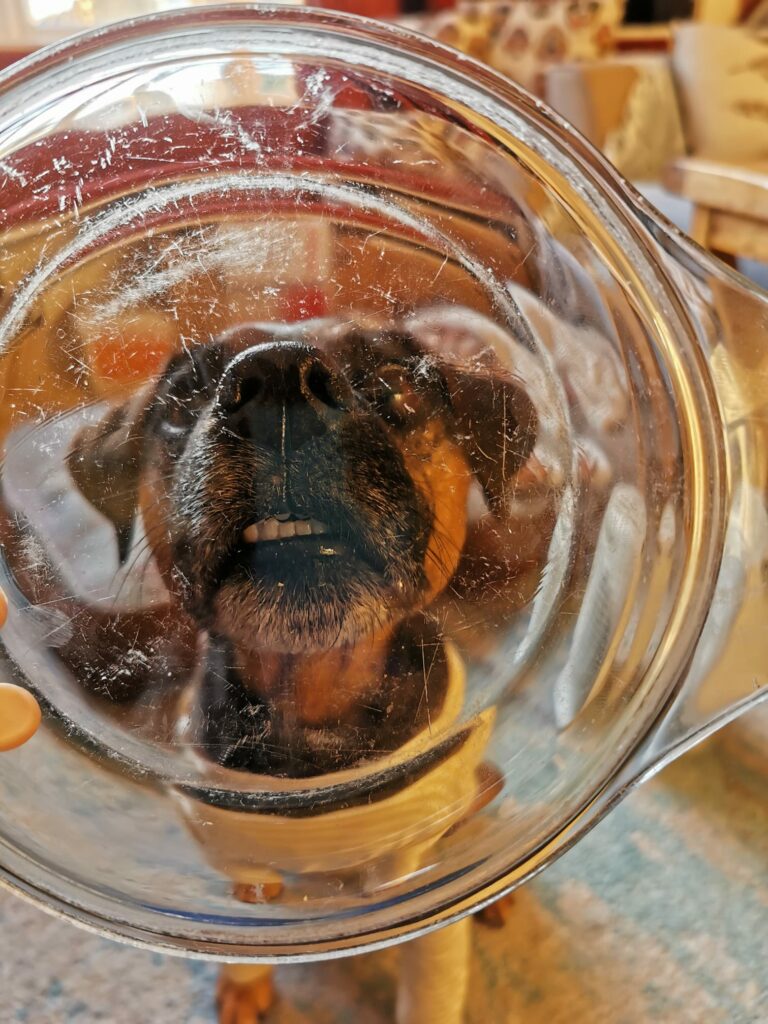Introduction
The world of dog food is an absolute minefield. I’m not qualified to give you direct advice on what to feed your dog but here’s some general guidance and further resources to look into. Assuming an average lifespan of 14 years and a feeding regime of 2 meals per day, that’s over 10,000 meals in your dog’s lifetime. If these meals are all the same and are subpar in any way, that’s an awful lot of opportunity to improve your dog’s life that you’re missing out on!
In short, the advice I’ll be giving here is to feed your dog the best diet you can afford for your dog. That stands for all types of diet, be they kibble, raw, homemade, fresh or canned. It’s really important to personalise the diet you feed to your individual dog(s). We don’t expect people to eat the exact same foods. My dietary needs as a 5 foot tall, long dog walker, agility handler who weight lifts is far different from the needs of my 6 foot plus partner who runs marathons (for fun!!!) There’s no way anyone could expect us to eat the exact same diet (even if the amount of food accommodated for calorie requirements). Yet, we often feed dogs within a household the exact same diet and just correct for different sizes of individual.

Types of Dog Food
- Dry, generally known as kibble
- Semi-moist kibble
- Wet (canned)
- Raw, either in mince or part/whole prey
- Fresh food, either purely fresh or a combination of any of the above with added fresh ‘human’ food
Base Diet & Finding The Right One
Before we get into the nitty gritty, let’s look at base diet. A base diet is a regular diet that you can feed your dog most days and add things to. This base diet can be any of the above kinds of food, and you can rotate through various types. Let’s say you like three kinds of kibble and rotate through buying a bag of each. A lot of advice says that you should change diets gradually and in my experience, as long as a dog is used to and ideally was exposed to regular changes in diet as a puppy then you’ll be okay to change base diet with some regularity.
What To Look For In A Base Diet
- Who makes the food? Could that company produce things that create financial incentive motivations that go against ideal diets for dogs? Brands that create foods are proud of the food they produce and will display transparency to reflect this. What qualifications do the individuals that formulate the food have? Bear in mind that like the training industry there is no regulation for canine nutritionists.
- “All natural ingredients with added vitamins and minerals” – If there are added vitamins and minerals, the source of these vitamins and minerals aren’t natural. Foods that say this should be avoided.
- Where are the proteins sourced from? You should aim to have ethical standards regarding this as you do with your own protein sources. If you choose not to eat animal proteins for whatever reason then search for ethical standards that you would have if you did eat meat.
- ‘Manufactured by…’ – companies that manufacture food themselves have more control over the whole process, generally resulting in higher hygiene and/or health standards.
- Ingredients – listed by weight, look for fresh meat sources rather than by-product or meat. Look for 65-80% of the food being protein based (there are circumstances where this changes but for the most part this stands). Grains and vegetables ideally coming from corn or wheat. Ideally fresh vegetables as the source of carbohydrates. Poached foods contain more natural vitamins and minerals and are a better option than baked foods.

Feed Fresh Revolution
Over the past few years, feeding fresh(er) diets has become all the rage. This is because of a wave of scientific evidence that has found that production of various feel-good chemicals important for wellbeing are actually produced in the gut as well as the brain, sometimes in higher proportions than in the brain! Serotonin production, for example, has up to 95% take place in the gut. Feeding fresh aids production of these feel-good chemicals and is therefore linked to improved mood and therefore, behaviour. What you feed has a direct link to how your dog feels.
In relation to what was discussed last week and what will be discussed in subsequent weeks, stress hinders the production of these feel-good hormones and can lead to runny tummies. If your dog regularly gets runny tummies then their diet is absolutely worth looking into.
Antibiotics kill a lot of the bacteria (as is their job!) that produce a lot of these feel-good chemicals in the gut. If your dog is antibiotics and you start to see runny tummies, don’t panic. That is to be expected. You can combat this by feeding a pro-biotic for the duration of the antibiotic treatment.
Moving On From Base Food
From your base food, the best thing you can do is to take away 50% of the portion for your dog’s meal. 25% because there’s an abundance of evidence that food recommendations suggest you overfeed by 25%. The other 25% will be replaced with fresh food. This can be dog-safe fruit or vegetable (google is your friend here, if in doubt don’t feed something), meat (either raw or lightly cooked) or other things like natural greek yoghurt, kefir, bone broth. These things will fuel the bacteria producing the feel-good chemicals in your dog’s gut. Add these as often as is convenient. I do these daily but even if you do them once a week they’ll benefit your dog.

Food Myths
- It’s perfectly safe to mix raw and cooked foods. No different to us eating raw carrots with cooked chicken
- Free feeding (leaving food down in a bowl all day) is as healthy as feeding meals. Free feeding is incredibly strongly correlated with obesity in dogs. Feeding meals allows you to identify any illnesses your dog may experience really quickly based on their response to each meal time
- There’s little scientific evidence to back up grain free diets and their supposed health benefits for dogs
We’ll be looking at more diet specifics this week across social media so keep an eye out for more from Functional Foundations June!
